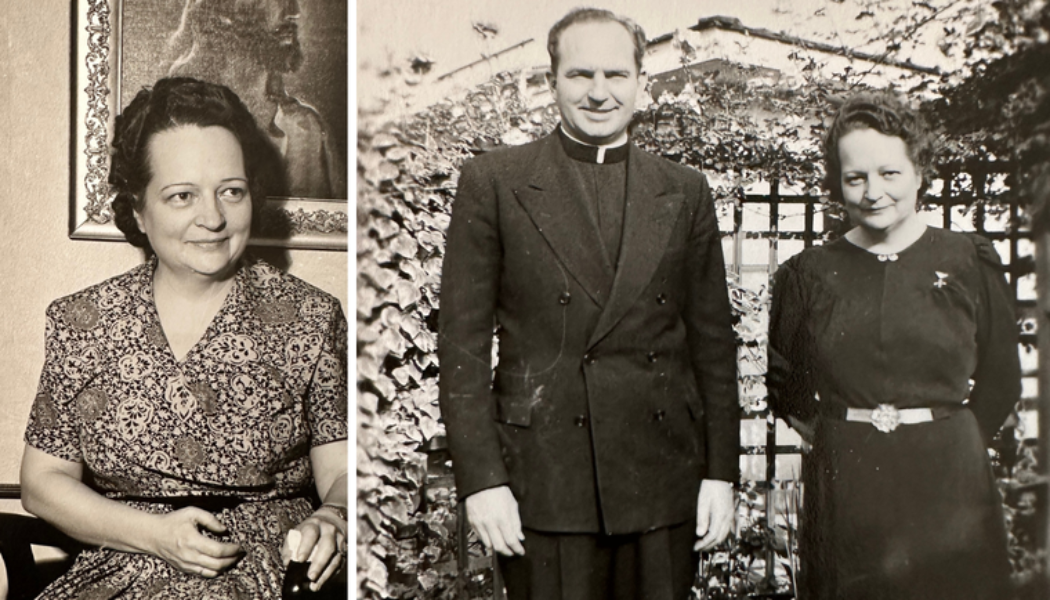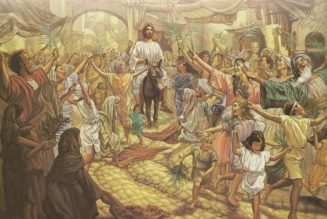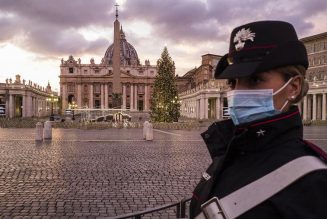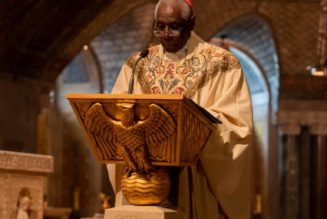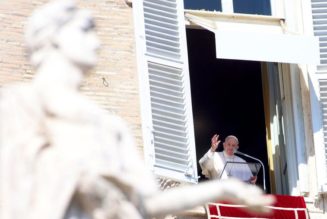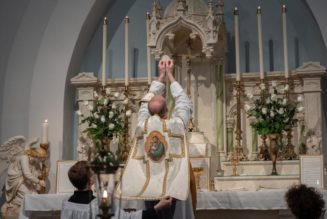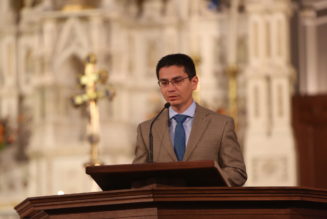
MENLO PARK, Calif. — When Catholics gather for Mass on Christmas Day this year, the readings for the liturgy will include one of the most famous and powerful passages from the Gospel of John: “And the Word became flesh and made his dwelling among us, and we saw his glory, the glory as of the Father’s only Son, full of grace and truth.”
The passage affirms the coming of the Christ Child as the fulfillment of God’s plan for the salvation of the world. But it does not describe the Virgin Mary’s actual experience delivering her Divine Son in that rough stable in Bethlehem.
Catholics hungry for such details must look elsewhere, and one place to consider is The Refugee From Heaven, an “eyewitness account” of the story of Jesus written by Servant of God Cora Evans, a California resident and convert from the Church of Jesus Christ of Latter-day Saints who became a mystic and stigmatist before her death in 1957.
The Refugee From Heaven describes St. Michael the Archangel tenderly creating a sanctuary for the Mother of God that allows her to receive the Son in private, prayerful union with the Father.
“In that ecstasy of joy, where the human senses are as though dead, and the spirit races to God, Mary was suddenly encased in a tremulous and unspeakably bright light,” reads one passage from the book. “That light, rising through her as a tower of ivory into the heavens as seen by the spiritual eye, was too bright even for the gaze of the angels, who hid themselves outside the sanctuary of God’s mother.”
An absorbing and more detailed account of key events that take place in the New Testament, Refugee provides additional context for the beheading of St. John the Baptist, the conversion of Mary of Magdala, and the humiliation of Peter during the Passion.
‘Private Revelation’
“This is private revelation, and we don’t have to believe it as literally true,” Father Vito Perrone, spiritual director at St. Patrick’s Seminary in Menlo Park, California, who has studied Refugee, told the Register. Father Perrone is the founder of the Contemplatives of St. Joseph, a religious family created to serve the Archdiocese of San Francisco.
“They are personal revelations and insights.” And like the Spiritual Exercises of St. Ignatius of Loyola, “you are placed in the Gospel setting and participating in the scene. You gain insights about yourself, the Lord and relationships with others … and this bears spiritual fruit.”
Now, following the U.S bishops’ unanimous vote on Nov. 16 to approve the “advancement of the cause of beatification and canonization of Servant of God Cora Evans,” Refugee will be among the vast trove of Evans’ spiritual writings to receive more intense scrutiny as the Holy See prepares to take up her cause.
“Cora wrote more than 3,000 pages of reflections, meditations, accounts of mystical visions, stories of Christ, Bible commentaries, morality vignettes and letters,” said Father Dennis McManus, a professor of theology at St. Patrick’s Seminary who has been charged with evaluating her legacy for a positio, an official document that will be forwarded to the Dicastery for the Causes of Saints and must also include a comprehensive record of the candidate’s life and faith and evidence of her growth in “heroic virtue” under difficult circumstances.
Ecclesial Scrutiny
At present, Father McManus is “slowly” reviewing every word penned by Evans, to see whether the record meets the criteria established by the Church as it scrutinizes candidates for beatification and canonization.
“First, is there anything contrary to Catholic belief, doctrine or practice?” said Father McManus. “Second, is there anything odd or unusual, something inappropriate that does not belong in the life of a saint? And, third, do these writings offer anything new or creative — something very distinctive — a real gift that the individual shares with the whole Church, like St. Thérèse and her doctrine of the ‘Little Way?’”
On that final point, he believes that the candidate’s deeply Eucharistic teaching on the “Mystical Humanity of Christ” to be especially “providential,” now that the U.S. bishops have launched their multiyear campaign to promote a Eucharistic Revival.
“A major theme in Cora’s writings harmonizes with a major movement in the Church in the U.S.,” he noted. “And that is to restore an understanding and practice of Eucharistic belief and evangelization.”
The news that Cora’s cause had reached a critical milestone delighted Catholics who have spent years bringing her life and writings to the attention of Church leaders and ordinary Catholics.
“The U.S. bishops’ vote was really important for us,” said Mike McDevitt, custodian of Evans’ writings and the executive director of the Mystical Humanity of Christ, Inc., which has taken up the mission entrusted to Cora: the “promulgation of the Mystical Humanity of Christ — the divine indwelling — throughout the world.”
Likewise, the new development has brought fresh attention to the hidden life of this “ordinary housewife” and mother who only received a rudimentary education yet produced writings that made “complex” theological principles broadly accessible.
“Despite her limited education, she presented complex Christological and soteriological ideas consistent with Catholic belief, but with new insights and a style accessible to the average reader,” said Bishop Daniel Garcia of Monterey, California, during remarks preceding the U.S. bishops’ vote to approve the advancement of the cause.
During the final year of her life, Evans resided in the diocese, and it will be forwarding the documents related to her cause to the Holy See.
Early Mormon Pioneers
Born in 1904, in Ogden, Utah, Cora Louise grew up in a family that traced its ancestry back to the early Mormon pioneers who settled in Utah. And as a very young child, she is reported to have had visions of Jesus and his mother.
Her family background made it possible for Cora and her husband, Maclellan “Mack” Evans, to be married in the Mormon Temple in Salt Lake City. But after the ceremony, she moved away from her cradle faith, rejecting a “doctrine that placed man-made gods above the God of Abraham.”
“I was without a God and religion but had gained a very wonderful husband,” Cora later explained. “As I looked at him and learned to love him more and more, I resolved to help find a God for him.”
“After ten years of searching, we found the One True God in the Roman Catholic Church,” she said.
The breakthrough came in 1934, while she was living in Ogden, a mother of two, after suffering the loss of her third child. Bedridden from recurring heart problems, Cora turned on the radio and heard a priest on The Catholic Hour, a national program produced in cooperation with the National Council of Catholic Men, speak about the Blessed Mother.
“It was like nothing she had ever heard about the Catholic Church,” said McDevitt, and “it sounded like a visionary experience she had had as a child.”
As soon as she was strong enough, Evans visited the town’s Catholic church to get her questions answered. Four months later, on March 30, 1935, she became a Catholic; and before long, she was handing out flyers that challenged misconceptions about Church teachings.
‘Hundreds of Conversions’
Her actions prompted hundreds of people to visit the local parish church, and several Mormon bishops came to her home to debate matters of Catholic doctrine with Father Edward Vaughn, pastor of St. Joseph’s Catholic Church in Ogden.
Over time, Cora paved the way for hundreds of conversions to the faith, according to Father Vaughn, as related by sources involved in Evans’ canonization cause. But her budding apostolate also sparked intense pushback from the Mormon community.
“Cora paid a high cost for her conversion,” Bishop Garcia reported during his comments at the bishops’ meeting. “Her parents and extended family shunned her, and the local community deprived her husband of work.”
In 1941, the family relocated to the Los Angeles area, where they remained for 15 years. Throughout this period, said McDevitt, Cora experienced episodes of spiritual ecstasy that brought her close to Jesus and his mother. In 1947, she also reportedly received the stigmata, though the wounds were not as extensive as those suffered by St. Pio of Pietrelcina, the Italian stigmatist who could read souls and bilocate.
A few years after the family arrived in California, Evans was brought to Loyola High School, and the provincial for the Society of Jesus in California, Father Joseph King, appointed Jesuit Father Frank Parrish, McDevitt’s uncle, to become her spiritual director.
“Father Parrish was with her most often when she went into ecstasy,” McDevitt told the Register. “He was governing her soul, in a sense, directing her to follow God’s will.”
On the back cover of The Refugee, which was completed in 1955 and published in 2014, Father Parrish wrote that the author was “with Christ in his life on earth. She witnessed many, many events in his life.”
In 1956, Evans and her family left Southern California and moved north to Boulder Creek, nestled in the Santa Cruz Mountains. Evans died the following year, 22 years to the day of her baptism in 1935.
After her death, “many have received favors through her intercession, though no miraculous events have been reported,” said Bishop Garcia in his remarks to the U.S. bishops. “During her life, there is evidence of her having cured a severely ill child whose parents had sought her intercession.”
Promoting the Cause
In 1992, Father Parrish asked McDevitt to be the custodian of Cora’s writings, and the following year they founded the Mystical Humanity of Christ annual retreats, and discussion groups centered on her writings followed in the years ahead.
In 2010, the group contacted the Diocese of Monterey to propose that it open Cora’s cause. An investigation was launched in 2012. It will be completed in January 2023, when the Holy See begins its review. And though her supporters understand that the next phase of the process could take decades or longer, they are inspired by the abundant fruits of her remarkable legacy.
Scott Borba, a seminarian enrolled at St. Patrick’s, told the Register that The Refugee From Heaven helped him clarify his priestly vocation, and he prayed for Evans’ intercession through this period of spiritual discernment.
“I was able to see Jesus as Cora saw him,” said Borba. “I became so madly in love with Our Lord, I didn’t want to do anything other than his will.”
Join Our Telegram Group : Salvation & Prosperity
